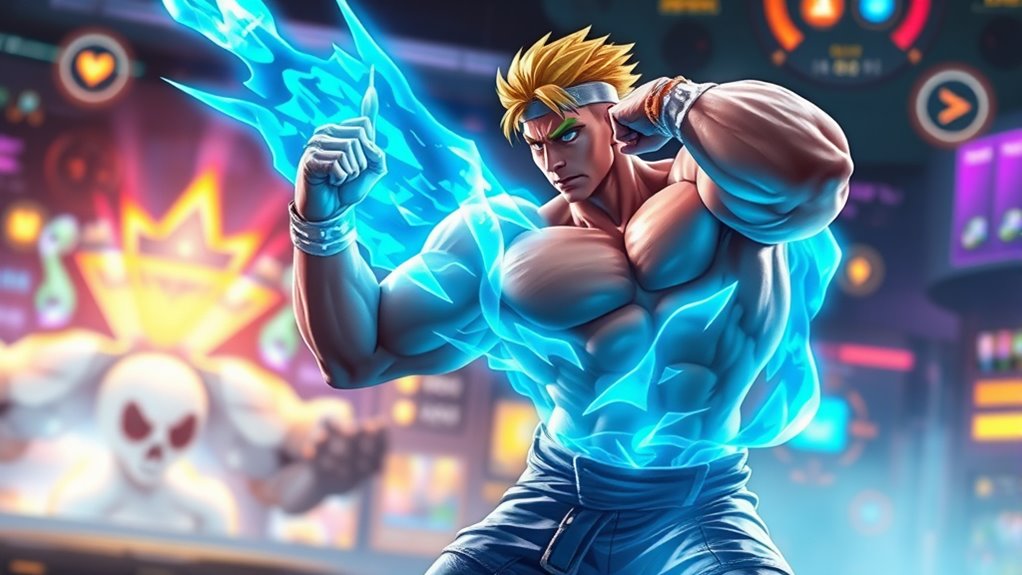In gaming slang, a “buff” means an increase in a character’s abilities, stats, or effectiveness to make them stronger or more useful during gameplay. Developers typically introduce buffs through updates, boosting damage, speed, or other attributes to improve balance and variety. Buffs can shift game strategies and keep players competitive. If you want to discover how buffs influence gameplay and strategy, keep exploring what these changes mean for your gaming experience.
Key Takeaways
- In gaming slang, a “buff” refers to an increase in a character’s abilities or stats.
- Buffs make characters or items more powerful, improving performance during gameplay.
- They are often applied through game updates to enhance balance and fairness.
- Buffs can be temporary or permanent boosts to damage, speed, or other attributes.
- Players use “buff” to describe the process or effect of strengthening in-game elements.
Defining the Term “Buff” in Gaming Contexts

In gaming, a “buff” refers to an increase in a character’s abilities, stats, or effectiveness, making them stronger or more effective in gameplay. Buff effects are designed to enhance performance, whether by boosting health, damage, speed, or other key attributes. Developers often implement buffs to improve game balancing, ensuring no single character or strategy dominates. These adjustments help create a more fair and competitive environment, encouraging diverse tactics and player engagement. When you encounter a buff, it generally means your character or team has received a temporary or permanent upgrade, increasing your chances of success. Understanding how buffs influence game balancing is essential for adapting your strategy and maximizing your gameplay potential. Additionally, high refresh rates can make gameplay feel smoother and more responsive, further enhancing the gaming experience.
How Buffs Differ From Nerfs and Other Game Changes

While buffs temporarily or permanently boost a character’s abilities, nerfs serve to weaken or reduce their effectiveness. These game changes are essential tools for maintaining game balance, ensuring no one strategy or character dominates. Buffs increase player empowerment by making certain characters or skills more impactful, encouraging diverse playstyles. Conversely, nerfs target overpowered aspects to prevent imbalance and promote fairness among players. Other game adjustments can include bug fixes or quality-of-life updates, which don’t directly alter power levels. Understanding how buffs differ from nerfs helps you grasp the ongoing effort developers make to keep gameplay engaging and balanced. Additionally, balancing strategies are crucial in ensuring that all players have a fair and enjoyable experience. Ultimately, these changes shape your experience, making gameplay fairer and more competitive.
Common Examples of Buffs in Popular Games

Have you ever noticed how a character suddenly becomes more powerful after a game update? That’s a buff in action, often designed to improve gameplay balance. Here are some common examples:
- Increased damage for weapons, making combat more exciting and rewarding.
- Faster character movement, enhancing your agility during multiplayer matchmaking.
- Improved character customization options, allowing you to tailor your hero’s strengths and appearance.
- Developers often use game updates to introduce buffs that keep gameplay fresh and engaging.
These buffs can make your favorite characters feel fresh and more effective, encouraging you to experiment with different strategies. When a game developer rolls out these updates, the overall experience becomes more dynamic, keeping players engaged and motivated to master new gameplay elements.
The Impact of Buffs on Gameplay and Strategy

When a character or item gets buffed, your performance can improve markedly, changing how you play. These enhancements often lead to a shift in game dynamics, making some strategies more viable than others. Understanding how buffs influence gameplay helps you adapt and stay competitive. Additionally, recognizing characteristics of a healthy buff can help you anticipate the impact on overall game balance.
Enhanced Player Performance
Buffs considerably boost a player’s performance, often turning the tide of a game in your favor. When you’re properly buffed, your actions become more effective, and your team’s synergy strengthens. This creates a competitive advantage that’s hard to beat. Imagine these moments:
- Dominating fights with increased damage or defense, leaving opponents stunned.
- Securing objectives faster, thanks to boosted speed or strength.
- Turning team fights into your favor, making it impossible for enemies to counter your moves.
These enhancements push your gameplay beyond ordinary limits, making you feel unstoppable. By leveraging buffs strategically, you maximize your impact, elevate your team’s performance, and gain the upper hand in every encounter.
Shift in Game Dynamics
Strategically applying buffs can dramatically reshape how a game unfolds, turning the tide in your favor and forcing opponents to adapt on the fly. These buffs often cause game meta shifts, altering which strategies and characters dominate. As a player, you need to stay alert and adjust your tactics quickly, since a buff can make a previously weak character powerful or change the effectiveness of certain skills. This dynamic keeps gameplay fresh and unpredictable, demanding high player adaptability. When you leverage buffs effectively, you can outsmart opponents who haven’t yet adjusted to the new meta. Ultimately, buffs influence not just individual performance but also the overall flow of the game, making strategic timing and awareness critical to maintaining an advantage. Additionally, understanding the impact of buffs on game balance can help players develop more effective strategies.
How Developers Implement Buffs in Game Patches

Developers implement buffs in game patches by adjusting character stats, abilities, or equipment parameters to enhance gameplay balance. They communicate these changes through detailed game patch notes, ensuring players understand the updates. When developers release a patch, you might feel a surge of excitement or hope, knowing your favorite character might become more powerful. Here are three ways they do it:
- Increasing damage or healing output to boost effectiveness.
- Improving ability cooldowns for quicker access to skills.
- Enhancing equipment stats to make gear more impactful.
- Carefully considering game balance to maintain fairness and competitiveness.
These modifications are carefully tested and explained via developer communication, so you stay informed and engaged. Buffs can dramatically shift your gameplay experience, making it more rewarding and dynamic.
The Role of Buffs in Player Progression and Balancing

In the context of competitive gaming and long-term progression, buffs play a crucial role in maintaining game balance and helping players grow more skilled. They can boost weaker characters or strategies, giving you new opportunities to improve and stay motivated. When buffs are well-designed, they enhance player motivation by making gameplay more engaging and rewarding. However, community reactions can vary; some players celebrate buffs that restore balance, while others may feel they disrupt established strategies. Properly implemented buffs ensure that no single approach dominates, encouraging diverse gameplay and sustained interest. Additionally, effective buffs often consider player feedback to fine-tune their impact and avoid unintended consequences. Ultimately, buffs are essential for balancing progression, keeping the game dynamic, and fostering a healthy, motivated community invested in continuous improvement.
Frequently Asked Questions
How Do Buffs Influence Competitive Gaming and Esports Strategies?
Buffs considerably impact competitive gaming and esports strategies by altering game balance, making certain characters or items more powerful. You need to adapt your strategies quickly to these changes, exploiting new opportunities or countering opponents’ buffs. Staying aware of recent buffs helps you make informed decisions, ensuring your team maintains an edge. Overall, understanding buffs allows you to optimize your gameplay and stay ahead in the fast-paced world of esports.
Can Buffs Be Temporary or Permanent Within a Game?
Buffs are like fireworks in a game—bright and impactful, but not always lasting. You can encounter both temporary effects and permanent enhancements. Temporary buffs might last only a few seconds or minutes, giving you a quick edge. Permanent buffs, on the other hand, stay with your character or team, continuously boosting abilities. Knowing when and how these buffs work helps you strategize better and stay ahead in the game.
Are Buffs More Common in Multiplayer or Single-Player Games?
Buffs are more common in multiplayer games because they help maintain game balance and add depth to player strategy. In multiplayer settings, developers use buffs to encourage varied tactics and prevent dominant strategies. You’ll find buffs less often in single-player games, where the focus is on narrative and challenge. By incorporating buffs in multiplayer, game designers create a dynamic environment that keeps players engaged and forces you to adapt your strategies.
How Do Players Typically React to Frequent Buff Changes?
Like sailors steering unpredictable seas, you often feel tossed by frequent buff changes. You react with player frustration, as balance adjustments seem to shift the game’s course unexpectedly. These rapid updates keep you on edge, unsure whether to adapt or resist. While some appreciate the effort to refine gameplay, others find the constant flux destabilizing, making it harder to master your favorite strategies and enjoy a steady, fair experience.
What Are Some Examples of Controversial Buffs in Gaming History?
You’ve probably seen controversial buffs like the nerf of Yasuo’s wind wall or the buff to Teemo’s mushrooms. These changes often spark balancing concerns, as developers aim to improve gameplay but sometimes cause unintended consequences. You might find players frustrated when buffs unbalance the game, making certain characters overpowered. Such updates highlight how tricky it is to tweak game mechanics without upsetting the delicate balance, leading to heated debates in gaming communities.
Conclusion
Understanding buffs helps you stay ahead in gaming strategies, as they can considerably boost your chances of winning. Did you know that in 2022, over 60% of major game updates included buffs to popular characters? By recognizing how buffs work and how developers use them, you can adapt faster and maximize your gameplay. Keep an eye on patch notes—you might just find the edge you need to outplay your opponents!









